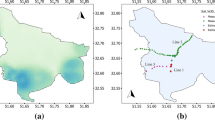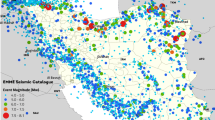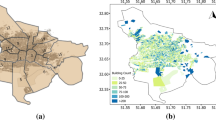Abstract
This study presents a seismic vulnerability and risk assessment of the residential building stock in Costa Rica. It proposes a new exposure model using housing census data, public construction statistics, and private construction information to quantify and characterize the residential building portfolio. A complete vulnerability catalogue is established by developing fragility functions for the most common building classes and combining them with existing models derived for risk assessment in South America. An existing probabilistic seismic hazard model was implemented within the OpenQuake-engine, and complemented with a simplified site model to account for site effects. Earthquake risk assessment is achieved by means of a probabilistic event-based analysis, which allowed the estimation of several risk metrics. These include average annualized losses at a national scale, disaggregated per building class and administrative regions. The probable maximum losses and exceedance probability curves were generated using a stochastic event set with 100,000 years of events per logic tree branch.









Source: CFIA construction prototypes (Yepes-Estrada et al. 2017) (left), numerical model used for the vulnerable assessment (right)







Similar content being viewed by others
References
Alvarado G, Benito B, Staller A, Climent A, Camacho E, Rojas W, Marroquín G, Molina E, Talavera JE, Martínez-Cuevas S, Lindholm C (2017) The new Central American seismic hazard zonation: mutual consensus based on up to day seismotectonic framework. Tectonophysics. https://doi.org/10.1016/j.tecto.2017.10.013
American Society for Testing and Materials (2001) Standard specification for low-alloy steel deformed and plain bars for concrete reinforcement, ASTM-706. Philadelphia, USA
American Society for Testing and Materials (2015) Standard specification for stress-relieved steel wire for prestressed concrete, ASTM A-421. Philadelphia, USA
Benito B, Lindholm C, Camacho E, Climent A, Marroquín G, Molina E, Rojas W, Escobar J, Talavera E, Alvarado G, Torres Y (2012) A new evaluation of seismic hazard for the Central America region. Bull Seismol Soc Am 102(2):504–523
Brzev S, Scawthorn C, Charleson A, Allen L, Greene M, Jaiswal K, Silva V (2013) GEM building taxonomy. Pavia, Italy
Cardona O, Ordaz M, Reinoso E, Yamín L, Barbat A (2012) CAPRA—comprehensive approach to probabilistic risk assessment: international initiative for risk management effectiveness. http://www.ecapra.org/. Accessed 1 Sept 2018
Chavez J, Khemici O, Keshishian P (2012) Building codes and relative seismic vulnerability in Latin American countries. In: World conference on earthquake engineering. Lisboa
Climent A (1994) Spectral strong motion attenuation in Central America. Technical report, NORSAR, pp 1–46
Climent A. (2003) Seismicity and physical vulnerability in the city of Cañas, Guanacaste, Costa Rica. In: Capacity building for natural disaster reduction for the RAPCA program, pp 1–35 (in Spanish)
Climent A, Rojas W, Alvarado A (2008) Evaluation of seismic hazard in Costa Rica. RESIS II report. RSN-CR, University of Costa Rica (in Spanish)
Concrete Products—PC (2015) Precast concrete housing manual. http://www.productosdeconcretocr.com/files/products/21_cat_esp_prefacat.pdf. Accessed 1 Sept 2018
Cornell C (1968) Engineering seismic risk analysis. Bull Seismol Soc Am 58(5):1583–1606
Costa Rican Chamber of Construction (2015) Economic report of the construction sector. San José, Costa Rica. http://www.construccion.co.cr. Accessed 1 Sept 2018
Crisafulli F (2002) Seismic behavior of reinforced concrete structures with masonry infills. Individual study. University of Canterbury, Christchurch
Crowley H, Bommer J (2006) Modelling seismic hazard in earthquake loss models with spatially distributed exposure. Bull Earthq Eng 4(3):249–273
D’Ayala D, Meslem A, Porter K, Rosseto T (2014) Guidelines for analytical vulnerability assessment of low/mid-rise buildings. Global Earthquake Model Foundation, Pavia
ERN-CAPRA (2009). Perfil de riesgo catastrófico por terremoto y huracán: Costa Rica. Metodología de modelación probabilista de riesgos naturales. Tomo I. Informe técnico ERN-CAPRA-T2-6
Federate Board of Architects and Engineers of Costa Rica - CFIA (2010) Costa Rica seismic code, 2010th edn. Editorial Tecnológica de Costa Rica, San José
Federate Board of Architects and Engineers of Costa Rica—CFIA (2014) Construction prototypes for the Costa Rican Central Bank. July 2014. http://www.bccr.fi.cr/estadisticas_macro_2012/. Accessed 1 Sept 2018
Federate Board of Architects and Engineers of Costa Rica—CFIA (2015) Index of construction costs of the federate board of architects and engineers. San José, Costa Rica (in Spanish)
Fernandez E (2011) Policy report: regularization of informal settlements in Latin America. Lincoln Institute of Land and Policy. Cambridge, Massachusetts, United States
Jalayer F, Cornell C (2002) Alternative nonlinear demand estimation methods for probability-based seismic assessments. Earthquake Eng Struct Dynam 38:951–972
Jayaram N, Baker J (2009) Correlation model for spatially distributed ground-motion intensities. Earthquake Engineering Structural Dynamics. 38:1687–1708
Kotha SR, Bazzurro P, Pagani M (2018) Effects of epistemic uncertainty in seismic hazard estimates on building portfolio losses. Earthq Spectra 34(1):217–236
Lamadrid G (2002) Seismic hazard and vulnerability assessment in Turrialba. International Institute for Geo-information Science and Earth Observation, Enschede
Lemoine A, Douglas J, Cotton F (2012) Testing the applicability of correlation between topographic slope and VS30 for Europe. Bulletin of Seismological Society of America. 102:2585–2599
Loaiza C, Blondet M, Ottazi G (2002) Housing report: adobe house. World house encyclopedia. Report 52
Mander J, Priestley N, Park R (1988) Theoretical stress–strain model for confined concrete. J Struct Eng 114(8):1804–1826
Ministry of National Planning and Economic Policy of Costa Rica (2010) The economic impact of extreme natural events in Costa Rica, 1988–2009. San José, Costa Rica (in Spanish)
Ministry of Treasury of Costa Rica (2015) Manual of real state assets. San José, Costa Rica (in Spanish)
Montoya A (2002) Urban disaster management: a case study of earthquake risk assessment in Cartago, Costa Rica. ITC 96:1–235
Morgat C, Zsutty C, Shah H, Lubetkin L (1977) A study of seismic risk for Costa Rica. Department of Civil and Environmental Engineering, Stanford University, Stanford (in Spanish)
Municipality of Alajuela (2016) Gallery of photography, Alajuela, Costa Rica. https://goo.gl/MSb758. Accessed 1 Sept 2018
Narciso J, Vilanova S, Carvalho J, Pinto C, Lopes I, Nemser E, Oliveira C, Borges J (2013) Site-condition map for Portugal based on Vs30 values and evaluation of the applicability of Vs30 proxies. In: Proceedings of the European geosciences union assembly, Vienna, Austria
National Institute of Statistics and Census—INEC (2016) Population and housing census—1973, 1984, 2000, 2011. San José, Costa Rica. http://www.inec.go.cr/sistema-de-consultas. Accessed 1 Sept 2018
National Institute of Statistics and Census—INEC (2016) National enquiry of homes—2010, 2011, 2012, 2013, 2014, 2015. San José, Costa Rica
Ordaz M, Arroyo D (2016) On uncertainties in probabilistic seismic hazard analysis. Earthq Spectra 32:1405–1418
Pagani M, Monelli D, Weatherill G, Danciu L, Crowley H, Silva V, Henshaw P, Butler L, Nastasi M, Panzeri L, Simionato M, Vigano D (2014) OpenQuake-engine: an open hazard (and risk) software for the global earthquake model. Seismol Res Lett 85(3):692–702
Papanikolaou A, Taucer F (2014) Review of non-engineered houses in Latin America with reference to building practices and self-construction projects. Institute for Protection and Security of the Citizenship, Ispra, Varese
Paté-Cornell E (1996) Uncertainties in risk analysis: six levels of treatment. Reliability Engineering & System Safety 54(2–3):95–111
Redmond L, DesRoches R (2012) Housing report: timber stilt homes. In: World house encyclopedia. Report 165
Ruiz-García J, Negrete M (2009) Drift-based fragility assessment of confined masonry walls in seismic zones. Eng Struct 31:170–181
Sadigh K, Chang C, Egan J, Makdisi F, Youngs R (1997) Attenuation relationships for shallow crustal earthquakes based on California strong motion data. Seismol Res Lett 68(1):180–189
Sauter F, Shah H (1978) Study of insurance for earthquakes. National Insurance Institute, San José (in Spanish)
Seismosoft Ltd. (2015) SeismoStruct user manual version 7.0. Seismsoft Ltd., Pavia
Silva V (2017) Critical issues on probabilistic earthquake loss assessment. J Earthq Eng. https://doi.org/10.1080/13632469.2017.1297264
Silva V, Crowley H, Pagani M, Monelli D, Pinho R (2014) OpenQuake-engine: an open hazard (and risk) software for the global earthquake model. Nat Hazards 13(5):1455–1490
Smyrou E, Blandon C, Antoniou S, Pinho R, Crisafulli F (2011) Implementation and verification of a masonry panel model for nonlinear dynamic analysis of infilled RC frames. Bull Earthq Eng 9(5):1519–1534
Sojo D, Denyer P, Gazel E, Alvarado G (2017) Geology of the Tapantí quadrant (1:50,000), Costa Rica. Revista Geológica de América Central 56:83–116 (in Spanish)
Tournon J, Alvarado G. (1993) Simplified geology map of Costa Rica. https://goo.gl/f3LkMW. Accessed 1 Sept 2018 (in Spanish)
United Nations Office for Disaster Risk Reduction (2015a) Costa Rica risk profile. http://www.preventionweb.net. Accessed 1 Sept 2018
United Nations Office for Disaster Risk Reduction (2015b) Global risk assessment data, methodology and usage. Annex 1. https://www.preventionweb.net/. Accessed 1 Sept 2018
United Nations Office for Disaster Risk Reduction (2015c) Chart of the Sendai framework for disaster risk reduction 2015–2030. https://www.preventionweb.net/files/44983_sendaiframeworkchart.pdf. Accessed 1 Sept 2018
Villar-Vega M, Silva V, Crowley H, Yepes C, Tarque N, Acevedo A, Hube M, Coronel G, Santa-María H (2017) Development of a fragility model for the residential building stock in South America. Earthquake Spectra 33(2):581–604
Wald D, Allen T (2007) Topographic slope as a proxy for seismic site conditions and amplification. Bull Seismol Soc Am 97:1379–1395
Wald D, Quitoriano V, Heaton T, Kanamori H (1999) Relationships between peak ground acceleration, peak ground velocity, and modified Mercalli intensity in California. Earthquake Spectra 15(3):557–564
Weatherill G, Silva V, Crowley H, Bazzurro P (2014) Exploring the impact of spatial correlations and uncertainties for portfolio analysis in probabilistic seismic loss estimation. Bull Earthq Eng 13(4):957–981
Wesson R, Perkins D, Luco N, Karaca E (2009) Direct calculation of the probability distribution for earthquake losses to a portfolio. Earthquake Spectra 25(3):687–706
World Bank (2017) Disaster risk profiles—Costa Rica. World Bank Group, Washington, D.C. http://documents.worldbank.org/. Accessed 1 Sept 2018 (in English)
World Bank Group (2017) Country disaster risk profiles: technical step-by-step guide to the CDRP property (building stock) model. https://collaboration.worldbank.org/docs/DOC-11634. Accessed 1 Sept 2018
Yepes-Estrada C, Silva V (2017) Probabilistic seismic risk in South America for the residential building stock. In: Proceedings 16th world conference on earthquake engineering, 9–13 January 2017, Santiago, Chile
Yepes-Estrada C, Silva V, Valcárcel J, Acevedo A, Tarque N, Hube M, Coronel G, Santa-María H (2017) Modeling the residential building inventory in South America for seismic risk assessment. Earthquake Spectra 33(1):299–322
Zhao Y, Zhang J, Asano J, Ohno A, Oouchi Y, Takahashi T, Ogawa T, Irikura H, Fukushima K, Thio Y (2006) Attenuation relations of strong ground motion in Japan using site classification based on predominant period. Bull Seismol Soc Am 96(3):898–913
Author information
Authors and Affiliations
Corresponding author
Ethics declarations
Conflict of interest
The authors declare that they have no conflict of interest.
Rights and permissions
About this article
Cite this article
Calderon, A., Silva, V. Probabilistic seismic vulnerability and loss assessment of the residential building stock in Costa Rica. Bull Earthquake Eng 17, 1257–1284 (2019). https://doi.org/10.1007/s10518-018-0499-1
Received:
Accepted:
Published:
Issue Date:
DOI: https://doi.org/10.1007/s10518-018-0499-1





